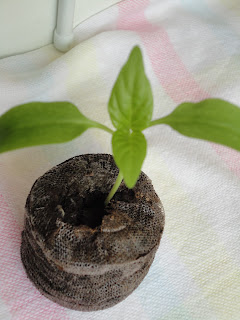I'll
admit it. I've been obsessed with this book since I originally read an
article about Peter Hatch and the restoration of Jefferson's gardens at
Monticello in the summer of 2010. That was the summer that I planted my
first heirloom garden. In my enthusiasm for the new pursuit, I
feverishly sought out and digested any tidbit of knowledge about
heirlooms that I could find. I was so inspired by the idea of Thomas
Jefferson as a pioneer in American gardening that I googled Hatch and
his book, only to find that it was still in the early planning stages.
Imagine my disappointment in finding out that I would have to patiently
await its publication! (To read the original New York Times article, see link below. It is definitely worth the read!)
http://www.nytimes.com/2010/07/01/garden/01monticello.html?ref=thomasjefferson
Fast forward two years later, and it is finally here! I advance ordered my copy on Amazon earlier this winter and the book arrived on my doorstep a few weeks ago. My husband was a smart enough man to make dinner that night, offering me the chance to snuggle up on the couch and savor my long awaited book.
Now, as a historian, I've studied the full breadth of American history and certainly have an appreciation for the Founding Fathers and their contributions to American politics and culture. But although I was aware that gardening took place on the property of many prominent early Americans, I never realized that Jefferson was somewhat of a pioneer and early gardening activist. As it turns out, Jefferson was responsible for bringing many of today's treasured heirlooms to America from across the globe. He avidly collected seeds during his travels, and brought them back to Monticello to experiment in his own garden. Jefferson's detailed journals for each year's garden have made it possible to accurately restore his gardens at Monticello. Hatch has spent the last 30 years overseeing the effort.
And the book itself? Breathtaking. The photos are beautiful, the research is impeccable, and the story is captivating. From a historian's perspective, Hatch provides a new depth to the understanding of Jefferson's character. From a gardener's perspective, the book serves as an inspiration to grow and treasure heirlooms.
http://www.nytimes.com/2010/07/01/garden/01monticello.html?ref=thomasjefferson
Fast forward two years later, and it is finally here! I advance ordered my copy on Amazon earlier this winter and the book arrived on my doorstep a few weeks ago. My husband was a smart enough man to make dinner that night, offering me the chance to snuggle up on the couch and savor my long awaited book.
Now, as a historian, I've studied the full breadth of American history and certainly have an appreciation for the Founding Fathers and their contributions to American politics and culture. But although I was aware that gardening took place on the property of many prominent early Americans, I never realized that Jefferson was somewhat of a pioneer and early gardening activist. As it turns out, Jefferson was responsible for bringing many of today's treasured heirlooms to America from across the globe. He avidly collected seeds during his travels, and brought them back to Monticello to experiment in his own garden. Jefferson's detailed journals for each year's garden have made it possible to accurately restore his gardens at Monticello. Hatch has spent the last 30 years overseeing the effort.
And the book itself? Breathtaking. The photos are beautiful, the research is impeccable, and the story is captivating. From a historian's perspective, Hatch provides a new depth to the understanding of Jefferson's character. From a gardener's perspective, the book serves as an inspiration to grow and treasure heirlooms.
Hatch, Peter J. "A Rich Spot of Earth": Thomas Jefferson's Revolutionary Garden at Monticello. New Haven, CT: Yale University Press, 2012.









